Ministry of Statistics & Programme Implementation
Results of Comprehensive Annual Modular Survey, July 2022- June 2023
Posted On:
09 OCT 2024 5:44PM by PIB Delhi
A. Key Findings
(i) Approximately 96.9 percent of persons aged 15-24 years are able to read and write simple statements with understanding and also able to perform simple arithmetic calculations. In the same age group, the figure stands around 97.8 percent for males and 95.9 percent for females.
(ii) The mean years of schooling in formal education, for persons age 15 years and above is 8.4 at the all-India level and the same is 7.5 for persons age 25 years and above.
(iii) The average out-of-pocket medical expenditure per household on hospitalization during last 365 days in rural and urban areas are Rs 4,129/- and Rs 5,290/-respectively. Additionally, the average out-of-pocket medical expenditure per household on non-hospitalization during last 30 days in rural and urban areas are Rs 539/- and Rs 606/- respectively.
(iv) Approximately 93.7 percent urban population has convenient access to low-capacity public transport (bus, car, taxi, auto etc) within 500 meters from the place of living.
(v) 78.4% of youth aged 15-24 years can send messages with attached files, while 71.2% can use copy-and-paste tools. Additionally, 26.8% can perform more advanced tasks like searching for information, sending emails, and conducting online banking.
(vi) 95.7% of persons aged 15-24 years in rural areas can use mobile phones, with the figure being 97% in urban areas.
(vii) 82.1% of rural youth aged 15-24 years can use the internet, compared to 91.8% in urban areas.
(viii) Around 94.6% persons aged 18 years and above, having an account individually are jointly in any bank / other financial institution at all India level.
B. Introduction
As a part of the 79th round of the National Sample Survey (NSS) the Comprehensive Annual Modular Survey (CAMS) was conducted from July, 2022 to June, 2023. The primary objective of CAMS was to collect data to generate indicators related to education, out-of-pocket medical expenditure, use of mobile and internet, financial inclusion, ICT skills, possession of assets, etc. In addition, information related to drinking water, sanitation, energy use, birth registration, access to transport facilities, etc., was also collected. The report is available on the Ministry’s website (http://www.mospi.gov.in).
C. Sample Design
In this survey, Two Stage Stratified Sampling was used, where First Stage Units (FSU) were villages/sub-units (SUs) in rural areas, and Urban Frame Survey (UFS) blocks/SUs in urban areas. The FSUs were allocated to States and UTs in proportion to the population as per Census 2011. The Second Stage Units (SSUs) were households in both rural and urban areas. The selection of FSUs and SSUs was done using Simple Random Sampling without Replacement (SRSWOR).
D. Survey Coverage
The survey covered the whole of the India Union except for some villages of Andaman and Nicobar Islands which were difficult to access. At the all-India level, the total number of first-stage units (FSUs) surveyed for the central sample was 15,298 (8,758 in rural areas and 6,540 in urban areas). The total number of households surveyed was 3,02,086 (1,73,096 in rural areas and 1,28,990 in urban areas) and the total number of persons enumerated was 12,99,988 (7,85,246 in rural areas and 5,14,742 in urban areas).
E. Comparability of results and release of unit-level data
The data collected in this survey represents the demand-side information of the households surveyed. In contrast, administrative data, wherever available, typically reflects the supply-side metrics. It is also important to recognize that respondents sometimes reluctant to provide specific information which may lead to under-reporting of some information, particularly in questions related to government schemes. Moreover, the coverage and definitions used in alternative data sources may not align perfectly with those adopted in this survey. To mention some specific cases, in this survey primary source of energy used by the household for cooking is defined as the source of energy which the household used majority of the time for cooking, whereas, the administrative record is based on the definition of the number of LPG connections/ consumers. Similarly, in this survey, the principal source of drinking water is defined as the source from which the household obtained most of its drinking water over the past 365 days, however, the administrative record is based on the number of pipe water connections provided. These variations in methodology, scope, and timeframes may affect the comparability of results across different data sources.
Additionally, this survey attempted to collect person-level information on the formal education of erstwhile household members aged 18 years or above who are currently studying outside India. However, the total number of samples representing the information is insufficient to generate reliable estimates for the indicator. Since the dataset is not robust enough for policy purposes, the unit-level data collected to generate the indicator will not be disseminated to avoid possible ambiguity in interpreting the results.
F. Major findings of the survey
(i) Percentage of persons able to read and write short simple statements in their everyday life with understanding and also able to perform simple arithmetic calculations
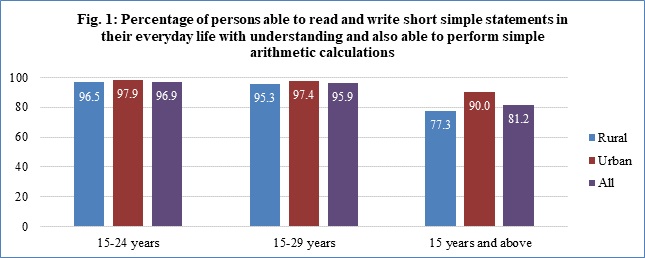
In rural areas, about 96.5 percent of persons in the age group 15-24 years are able to read and write short simple statements in their everyday life with understanding and also able to perform simple arithmetic calculations while in urban areas it has been around 97.9 percent. Sector-wise estimates for different age groups are shown in Figure 1.
(ii) Mean years of schooling in formal education
The gender-sector-wise mean years of schooling in formal education for age 15 years and above and 25 years and above is given in Figure 2 and Figure 3 respectively. The mean years of schooling in formal education is marginally higher in the age group 15 years and above compared to the age group 25 years and above.
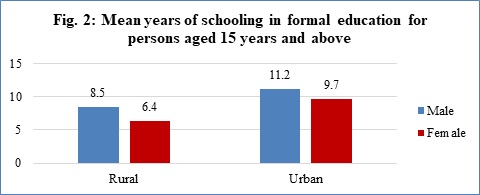
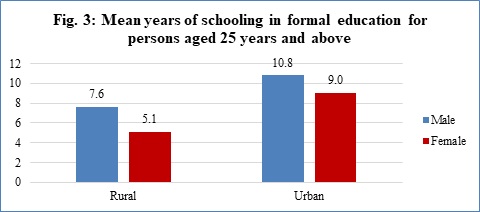
(iii) Average out-of-pocket medical expenditure
The average out-of-pocket medical expenditure per household and per person on hospitalized treatment during last 365 days and non-hospitalized treatment during last 30 days were estimated separately for rural and urban India. Figure 4 and Figure 5 present sector-wise expenditure on different types of treatment.
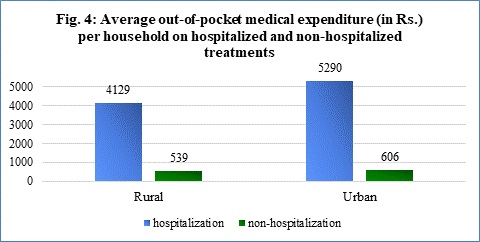
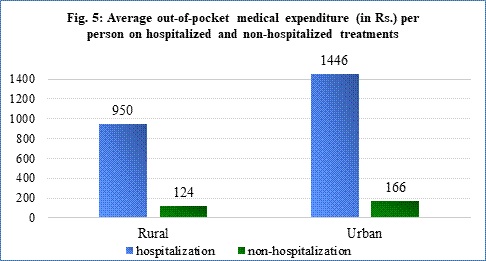
F. In addition to the above, estimates of some of the indicators at the all-India level are given below:
|
Sl No
|
Item Description
|
Rural
|
Urban
|
All
(Rural + Urban)
|
|
1
|
Percentage of persons aged 15-24 years able to read and write short simple statements in their everyday life with understanding
|
96.7
|
98.0
|
97.0
|
|
2
|
Percentage of persons of age 6 to 10 years who reported as currently enrolled in primary education (Class I to Class V) at the time of survey
|
90.5
|
89.2
|
90.1
|
|
3
|
Percentage of persons of age 25 years and above with some secondary education
|
30.4
|
56.6
|
38.6
|
|
4
|
Percentage of persons of age 6 to 18 years who never enrolled in formal education
|
2.2
|
1.9
|
2.1
|
|
5
|
Percentage of persons aged 21-35 years who graduated in Science and Technology among all graduates
|
31.4
|
44.4
|
37.8
|
|
6
|
Precentage of youth in formal and non-formal education and training in the previous 12 months in the age group 15-24 years
|
45.9
|
57.1
|
49.0
|
|
7
|
Percentage of youth reported to be not in education, employment, or training, as on date of survey for the age group 15-24 years
|
25.0
|
19.0
|
23.3
|
|
8
|
Percentage of persons (age ≥ 18 years) who have an account individually or jointly in any bank/ other financial institution/mobile money service provider
|
94.6
|
94.4
|
94.6
|
|
9
|
Number of borrowers (age ≥ 18 years) per 1,00,000 persons
|
18,714
|
17,442
|
18,322
|
|
10
|
Percentage of persons able to use mobile (including smart phone) as on date of survey (age 15-24 years)
|
95.7
|
97.0
|
96.1
|
|
11
|
Percentage of persons who used mobile telephones with an active sim card, at least once, during the last three months preceding the date of the survey (age 15-24 years)
|
92.6
|
95.3
|
93.3
|
|
12
|
Percentage of persons able to use internet as on date of survey (age 15-24 years)
|
82.1
|
91.8
|
84.8
|
|
13
|
Percentage of persons who used internet during last three months preceding the date of survey (age 15-24 years)
|
80.4
|
90.8
|
83.3
|
|
14
|
percentage of persons covered by 4G or above mobile technology
|
99.5
|
99.8
|
99.7
|
|
15
|
Percentage of persons aged 15-24 years reported execution of skill of ‘sending messages (e.g., e-mail, messaging service, SMS) with attached files (e.g., documents, pictures, and video)’
|
74.9
|
87.3
|
78.4
|
|
16
|
Percentage of persons aged 15-24 years reported execution of skill of ‘copy and paste tools to duplicate or move data, information, documents, etc.’
|
67.1
|
81.8
|
71.2
|
|
17
|
Percentage of persons who can search internet for information and who can send or receive emails and who can perform online banking transactions simultaneously in the age group 15-24 years
|
21.0
|
40.2
|
26.8
|
|
18
|
Percentage of households possessing telephone/ mobile phone1
|
94.2
|
97.1
|
95.1
|
|
19
|
Percentage of households possessing computer2
|
4.2
|
21.6
|
9.9
|
|
20
|
Percentage of the urban population having convenient access to high-capacity public transport (train, metro, ferry etc.) within 1 km from place of living
|
-
|
41.6
|
-
|
|
21
|
Percentage of the rural population with all-weather roads within in a distance of 2 km from the place of living
|
94.2
|
-
|
-
|
|
22
|
percentage of persons of age less than 5 years who have registered with civil authority for the birth certificate ever (including those who received birth certificates)
|
90.5
|
90.8
|
90.6
|
|
23
|
Percentage of households using clean fuel for cooking (among households reported having cooking arrangements)
|
49.3
|
92.9
|
63.4
|
|
24
|
Percentage of households having access to improved principal source of drinking water
|
94.9
|
97.5
|
95.7
|
|
25
|
Percentage of households having access to improved latrine (among households with access to latrine)
|
97.1
|
98.9
|
97.8
|
|
Notes:
1. telephone includes landline and mobile phone includes smart phone
2. Computer includes desktop PC, laptop etc.
|
*****
SB/DP/ARJ
(Release ID: 2063571)
Visitor Counter : 2210